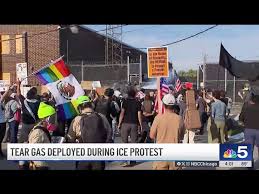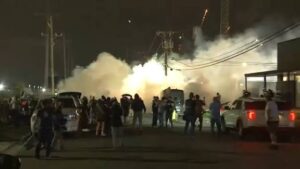ICE Clash at Broadview: Tear Gas & Arrests in Overnight Protest

During a deadlock with protesters on Friday morning, ice deployed tear gas and pepper balls in the group. Today we will discuss about ICE Clash at Broadview: Tear Gas & Arrests in Overnight Protest
ICE Clash at Broadview: Tear Gas & Arrests in Overnight Protest
On a tense Friday morning in Broadview, Illinois, dozens of protesters clashed with federal agents outside the ICE (Immigration and Customs Enforcement) facility. The confrontation—marked by tear gas, pepper balls, arrests, and a charged political atmosphere—came in the wake of a sweeping enforcement initiative dubbed Operation Midway Blitz, which has seen hundreds of arrests in the Chicago area. What began as a peaceful demonstration erupted into repeated standoffs as protesters sought to block ICE vehicles, speak out against immigration policy, and demand accountability. The confrontation raises urgent questions about civil liberties, law enforcement tactics, and the politics of immigration enforcement in the Trump administration era.
Background: Operation Midway Blitz and ICE Enforcement

ICE’s Operation Midway Blitz is the catalyst that brought demonstrators to Broadview. Launched less than two weeks before the protest, the operation aimed to escalate immigration enforcement in the Chicago metropolitan area. Federal officials have arrested nearly 550 people in that span.
As the operation intensified, so did public outcry and organized resistance, particularly among immigrant communities, activists, and political figures. Broadview’s ICE facility has become a flashpoint: detained individuals are housed there, and its yard entrance, gates, and driveways are regularly the site of protests. The facility’s windows have reportedly been boarded up for weeks, in anticipation of unrest.
The Protest Begins: Early Morning and Tactics
The confrontation at Broadview began early—around 5:00 AM—when protesters gathered outside the ICE processing center. Their aims were relatively straightforward: speak out publicly against what they viewed as unjust immigration policies, demand transparency around detainee treatment, and disrupt the flow of ICE vehicles entering and exiting the facility. Many protesters attempted to block vehicles. Some chained arms. Others stood directly on driveways.
On the other side, federal agents guarded the gates, with some posted on the roof of the building. Among those present was Gregory Bovino, the Border Patrol Chief who has been involved in similar enforcement operations. Tensions rose when ICE vehicles tried to move: protesters blocked entrances, and agents had to maneuver around them. These moments became flashpoints for escalation.
Escalation: Tear Gas, Pepper Balls, and Physical Confrontations
As the morning progressed, the protest escalated. Agents deployed tear gas, fired pepper balls (nonlethal projectiles meant to disperse crowds), and used other chemical irritants. Demonstrators, including political candidates, legal observers, and journalists, reported difficulty breathing, stinging eyes, and chaotic scenes.
One of the more dramatic incidents involved Kat Abughazaleh, a Democratic candidate running for Illinois’s 9th Congressional District. She was allegedly thrown to the ground twice by federal agents as she and other protesters blocked a driveway. She described the scene as chaotic, with agents moving quickly, aggressive in their tactics.
At multiple points, protesters attempted to block vans entering or exiting the facility. In response, agents used less-lethal force—pepper balls, tear gas, and what some described as chemical irritants. Videos shared on social media show clouds of white gas, protesters covering their eyes, coughing, and being physically removed.
Arrests, Injuries, and Claims of Excessive Force
Arrests were made throughout the day. Sources report three arrests by morning related to the initial clashes. Later in the day, additional detainees were taken as confrontations repeated in the afternoon and evening. Some reports estimate at least ten arrests by day’s end.
Injuries and condition‐issues were also reported. Protesters said many suffered from irritant exposure, some requiring water or medical attention. Observers, legal monitors, and media present said tear gas and pepper spray were used not only against those actively blocking vehicles but also among the crowd more broadly—including people holding signs, chanting, or simply watching.
Claims & Counterclaims: Who Did What
With such confrontations, claims and counterclaims quickly surfaced.
Protester / Advocate Claims:
-
Many protesters and political figures contend their demonstration was predominantly peaceful, and the response from ICE was disproportionate. Kat Abughazaleh said, for example, that she, and others, had no weapons—just signs, chants, and solidarity.
-
Legal observers (including the Chicago chapter of the National Lawyers Guild) accuse law enforcement of indiscriminate use of nonlethal force—tear gas, pepper balls—impacting even media and observers.
-
There are also reports of overreach: protesters allege ICE agents pulled people off the ground, carried or dragged them, used chemical irritants even when there was no clear danger. Abughazaleh, for one, described being lifted by her chest and thrown onto the asphalt.
Federal Authorities / ICE / DHS Claims:
-
The Department of Homeland Security (DHS) has defended the response, saying protesters “assaulted law enforcement, threw tear gas cans, slashed tires, blocked the entrance of the building, and trespassed on private property.”
-
DHS has also characterized the protests as attempts to obstruct ICE operations. According to their statements, federal officers are facing increased aggression, including use of vehicles as weapons in some cases.
-
They maintain that the arrests were justified based on actions interfering with ICE’s operational mandate.
Political Fallout and Broader Context
The protest at Broadview does not exist in a vacuum. There are broader political stakes and symbolic elements that have heightened tension.
-
Several Democratic politicians and Congressional candidates—like Daniel Biss, Kat Abughazaleh, Bushra Amiwala—were present. Their participation isn’t just symbolic; for some, it is front and center in their platforms.
-
Local government figures also weighed in. Broadview’s Mayor Katrina Thompson criticized some of the protesters and political figures for “provocative campaign activities,” suggesting activism isn’t without cost and that local community safety can be compromised.
-
On the other hand, advocates argue that immigration policies, enforcement tactics, and detention conditions need public scrutiny, especially when health, human rights, or procedural justice might be compromised. The protest is part of a rising wave of resistance to what many see as harsh immigration enforcement under the current federal policy.
Human Stories: Families, Fear, and Advocacy
Behind the headlines are deeply personal stories of fear, separation, and health concerns.
-
Some protesters were there because they have loved ones inside the Broadview facility—parents, partners, community members—and wanted to ensure they were being treated fairly, receiving medication, or at least that their basic rights were respected.
-
One woman described her partner being detained after ICE stopped him near a location he was asked to drive to, allegedly under false pretenses, and was held in the facility with little clarity given to the family.
-
Others spoke about fear—fear of being arrested themselves, fear of what happens behind the walls of the facility, fear of living in limbo. At the same time, many said they felt compelled to act because silence was no longer an option.
Legal, Ethical & Constitutional Questions
The clash at Broadview raises significant questions in terms of constitutional law, civil rights, and the ethical boundaries of enforcement tactics.
-
The First Amendment protects the right to protest. However, U.S. law also limits that right in certain circumstances—when protests interfere with government operations, block official access, or pose safety threats. Determining when protest crosses that line is often contested. The ACLU of Illinois has commented that while protest is protected, actions like puncturing tires or obstructing government vehicles may not be.
-
Use of force: The deployment of tear gas, pepper spray, pepper balls, and physical removal are “nonlethal” but not risk-free. Questions arise about proportionality, whether law enforcement exhausted de-escalation possibilities, whether the crowd was given warnings, whether any medical assistance was offered, and whether any bystanders or media present were harmed.
-
Transparency and oversight: With ICE/detention centers often out of public view, protests become one of the few ways the public learns about what is happening. Families have complained about limited information—about health, conditions, transfers, legal status—while the government cites security, ongoing operations. Balancing public information and operational security is difficult but critical.
-
Legality of arrests: Some arrests seem tied to blocking entrances or entrances and exits, or interfering with operations. Others may be more debatable, especially where protesters claim they did not physically block, only spoke, held signs, or meditated. The details matter: what exactly individuals were doing at the moment of arrest, whether the government had issued clear orders or warnings beforehand, whether force used was proportional.
The Scale and Escalation: What Happens Next?
Given that Operation Midway Blitz is ongoing, the Broadview clash seems likely to be only one among many protests, confrontations, and legal and political fights that lie ahead.
-
Arrest figures will be watched closely. As of this protest, the DHS has claimed “nearly 550 people” arrested in the Chicago region under the operation.
-
Protester tactics may escalate: more blockages, more direct obstruction, possibly more civil disobedience, more nights of protest. The presence of political candidates makes these protests more visible and transmittable through media and social platforms, which in turn can draw more supporters—and more critics.
-
On the government side, expect further justifications of enforcement measures. ICE and DHS have emphasized the need to enforce immigration law, maintain border security, and deport individuals deemed in violation of federal laws. There may also be legal action—claims of civil rights violations, lawsuits, calls for investigations into use of force.
-
Public opinion will be a key battleground. Media coverage, especially visual images of tear gas, protests, and injured demonstrators, tends to amplify sympathy for protesters—but counternarratives often highlight law enforcement burden, rights of property or facility protection, safety concerns. This can affect elections, policy proposals at state and federal levels.
Conclusion
The Broadview protest is a microcosm of several converging issues: the intensification of U.S. immigration enforcement under the Trump administration; the struggle over where the line lies between peaceful protest and obstruction of enforcement activities; the physical risks faced by those who protest; and the political stakes for both those demanding reform and those defending current policies.
As the tear gas cleared and arrests were made, one thing was certain: neither side considered retreating. For protesters and community members, standing up—despite risk—was deemed necessary. For federal agencies, enforcing laws and protecting operations was equally non-negotiable.
The broader question remains: Will policy, oversight, or legal precedent evolve in response to these flashpoints? Or will we see more Broadviews—more early-morning protests, more clashes, more legal wrangling? For now, this is a moment of tension, visibility, and uncertainty—and the consequences will likely ripple out far beyond the gates of the ICE processing center.
How useful was this post?
Click on a star to rate it!
Average rating 0 / 5. Vote count: 0
No votes so far! Be the first to rate this post.
About the Author
usa5911.com
Administrator
Hi, I’m Gurdeep Singh, a professional content writer from India with over 3 years of experience in the field. I specialize in covering U.S. politics, delivering timely and engaging content tailored specifically for an American audience. Along with my dedicated team, we track and report on all the latest political trends, news, and in-depth analysis shaping the United States today. Our goal is to provide clear, factual, and compelling content that keeps readers informed and engaged with the ever-changing political landscape.




